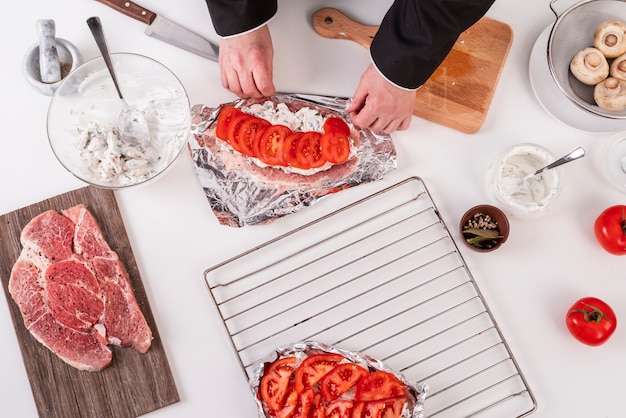You've heard the whispers, haven't you? About this "flat iron" cut of steak, the one that's supposedly bursting with flavour and surprisingly affordable. Well, let me tell you, mate, those whispers are true. As a bit of a steak connoisseur myself, I've discovered that the flat iron is a real hidden gem, a true underdog in the world of beef. It's got that incredible marbling that makes your mouth water, and it's incredibly tender, especially when cooked just right. So, grab a comfy chair, pour yourself a cuppa, and let's dive into the world of flat iron steak together.
(Part 1) Unveiling the Mystery of the Flat Iron

Before we get our hands dirty with the cooking, let's have a little chat about what exactly this flat iron cut is all about. You see, it's a cut from the shoulder blade of the cow, and it's got this unique lean flavour that's simply irresistible. Now, you might be thinking, "Shoulder blade? Sounds a bit tough, doesn't it?" But don't worry, this cut is surprisingly tender, especially when cooked correctly. It's got this fantastic balance of price and quality that makes it a real favourite among home cooks and even some fancy chefs.
The Flat Iron's Secret Weapon: Tenderness
Here's the thing, the flat iron muscle isn't used much by the cow, so it's naturally more tender than other cuts from the shoulder. It's got this distinctive, almost rectangular shape, with a visible "grain" running along the steak. That's the muscle fibre, and it's important to understand how to work with it for the best results. But we'll get to that later.
(Part 2) Choosing the Perfect Flat Iron Steak

Alright, now that we've got a good understanding of what we're looking for, let's head to the butcher or the supermarket and pick out the perfect flat iron steak.
Marbling: The Key to Juiciness
The first thing you'll want to check is the marbling, that beautiful, white fat that's interspersed throughout the meat. The more marbling you see, the juicier and more flavourful the steak will be. Aim for a good amount of marbling, but not too much, as that can make the steak a bit too greasy.
Freshness: The Smell Test
Always check the use-by date, and don't be shy, give the steak a good sniff. It should smell fresh and a little sweet, not sour or ammonia-like. The meat should be firm to the touch, and the colour should be a nice, even red.
Thickness: The Goldilocks Factor
Ideally, you want a flat iron steak that's about 1-1.5 inches thick. That's the perfect thickness for even cooking, preventing the steak from drying out. If you find a thicker steak, no worries, just slice it into thinner pieces before cooking. And if it's a bit thinner, don't stress, we'll just adjust the cooking time a bit.
(Part 3) Preparing the Flat Iron for a Star Turn

Now we're getting to the fun part, pre-game prep! You've got your perfect flat iron steak, but there are a few key steps before you fire up the heat.
Room Temperature: The Patient Approach
First, take your steak out of the fridge and let it chill out at room temperature for about 30-45 minutes. This lets the steak reach a more even temperature, which helps it cook more consistently. It also makes it easier to sear and achieve that irresistible crispy crust.
Seasoning: A Symphony of Flavour
Now, it's time to season your steak. Don't be shy, let your creativity flow! I like to keep it simple with salt, pepper, and a touch of garlic powder. But you can get creative with herbs like rosemary, thyme, or oregano, or even add a pinch of paprika or chili flakes for a bit of heat. Remember, a little goes a long way.
Pat it Dry: The Secret to a Crispy Crust
Before you start cooking, pat your steak dry with a paper towel. This is a crucial step to get that perfect, crispy sear. It prevents the steak from steaming on the pan instead of browning, which wouldn't be good for our crispy crust goals.
(Part 4) The Art of Cooking: Pan or Grill, You Decide!
Alright, here's where the magic truly happens. Cooking a flat iron steak isn't rocket science, but there are a few things to keep in mind for the best results. Let's explore two popular methods: pan-frying and grilling.
The Pan Method: Simple, Efficient, and Delicious
My go-to method is pan-frying. It's simple, efficient, and perfect for achieving that gorgeous crispy crust we talked about. You'll need a heavy-bottomed pan, like cast iron, that can get really hot. Heat it up over medium-high heat, then add a tablespoon or two of oil, like olive oil or grapeseed oil.
Understanding the Grain: The Key to Tenderness
Now, remember that "grain" we talked about earlier? It's crucial to understand its role. You always want to cook your steak perpendicular to the grain. This means the grain should be running across the pan, not along it. It prevents the steak from shrinking and becoming tough.
Searing for Perfection: The Crispy Crust Dream
Leave the steak undisturbed for about 3-4 minutes per side, or until you see a beautiful, golden-brown crust forming. Then, flip the steak over and repeat. You're aiming for an even sear all over. Now, depending on how you like your steak, you can either finish it off on the stovetop or transfer it to the oven.
Finishing Touches: Tailoring to Your Preferences
For medium-rare, cook for about 4-5 minutes total, for medium, about 6-7 minutes, and for medium-well, about 8-9 minutes. But remember, this is just a guideline. You might need to adjust the cooking time based on your pan's heat and the thickness of your steak.
The Grill Method: Smoky Flavour and Backyard Bliss
If you're more of a grill enthusiast, the flat iron is a fantastic choice for the grill as well. Preheat your grill to medium-high heat, and make sure the grill grates are clean and lightly oiled.
Direct and Indirect Heat: The Two-Step Grill Approach
For this method, you'll use a combination of direct and indirect heat. You'll sear the steak over direct heat for about 3-4 minutes per side to get that crispy crust. Then, you'll move the steak to the cooler, indirect side of the grill to finish cooking. This ensures the steak cooks evenly and doesn't become overcooked.
Temperature Control: The Key to Grill Mastery
Keep a close eye on the temperature of your grill and adjust accordingly. If the grill is too hot, the steak will burn before it cooks through. If it's too cool, the steak will take forever to cook. You're aiming for that sweet spot where you get a nice, even sear and perfect internal doneness.
(Part 5) Mastering the internal temperature: The Science of steak doneness
How do you know when your flat iron steak is cooked to your liking? A meat thermometer is the most accurate way to gauge the internal temperature. Here's a handy table for reference:
| Doneness | Internal Temperature (°F) | Internal Temperature (°C) |
|---|---|---|
| Rare | 125-130 | 52-54 |
| Medium-Rare | 130-135 | 54-57 |
| Medium | 135-140 | 57-60 |
| Medium-Well | 140-145 | 60-63 |
| Well-Done | 145 | 63 |
But if you don't have a thermometer, you can also use the "touch test." Gently press on the centre of the steak. If it feels soft and springy, it's rare. If it feels firmer, but still gives a bit, it's medium-rare. If it feels firm and doesn't give at all, it's medium.
(Part 6) Resting: Giving the Steak a Moment to Breathe
Once your steak is cooked, resist the urge to slice into it right away. It needs to rest for about 5-10 minutes before you cut it. This allows the juices to redistribute throughout the steak, resulting in a more tender and flavourful bite.
While the steak is resting, you can whip up your favourite sides. Roasted vegetables, creamy mashed potatoes, or a simple salad all pair beautifully with a flat iron steak.
(Part 7) Slicing and Serving: Unveiling the Culinary Masterpiece
After the resting period, it's time to slice your flat iron steak. Remember, you always want to slice your steak against the grain. This means cutting across the muscle fibres, which makes the steak easier to chew and more tender.
Serve the steak immediately with your favourite sides. I personally love a nice drizzle of pan sauce on top, or a dollop of butter. And don't forget a glass of your favourite red wine to complete the experience!
(Part 8) Mastering the Variations: From Classic to Creative
The beauty of the flat iron steak is its versatility. You can experiment with different marinades, rubs, and sauces to create a whole range of flavour profiles. Let's explore some options:
Marinades: A Burst of Flavour
Marinades can add a burst of flavour and tenderness to the steak. Try classic marinades like balsamic vinegar, olive oil, garlic, and herbs, or get creative with citrus marinades, soy sauce marinades, or even spicy marinades.
Rubs: Adding Depth and Crispness
dry rubs are fantastic for adding depth of flavour and a crispy crust to the steak. You can find pre-made rubs at the supermarket, or create your own using a combination of spices like paprika, garlic powder, onion powder, cumin, chili powder, or smoked paprika.
Sauces: The Finishing Touch
Sauces can elevate your flat iron steak to new heights. Try classic steak sauces like béarnaise sauce, chimichurri sauce, or a simple red wine sauce. Or get creative with pesto sauce, salsa verde, or even a spicy sriracha sauce.
(Part 9) FAQs: Answering Your Flat Iron Steak Questions
You've got questions, I've got answers. Let's tackle those common flat iron steak inquiries.
1. Can I cook a flat iron steak on a cast iron skillet?
Absolutely! A cast iron skillet is a perfect choice for cooking a flat iron steak. It heats up evenly and retains heat well, which helps to achieve a beautiful sear. Just make sure you preheat the skillet over medium-high heat and add a tablespoon or two of oil before adding the steak.
2. What is the best way to get a crispy crust on a flat iron steak?
The secret to a crispy crust is a hot pan or grill, a dry steak, and a little patience. Pat the steak dry with paper towels before cooking, preheat your pan or grill to high heat, and let the steak cook undisturbed for about 3-4 minutes per side before flipping. You should see that beautiful, golden-brown crust developing.
3. Can I use a flat iron steak for a stir-fry?
Yes, you can absolutely use a flat iron steak for a stir-fry. Just slice the steak thinly against the grain and stir-fry it with your favourite vegetables and sauce. It adds a great protein boost and a delicious flavour to your dish.
4. What happens if I overcook my flat iron steak?
Overcooking your flat iron steak will make it tough and dry. It's important to avoid overcooking at all costs. Use a meat thermometer to monitor the internal temperature, and don't be afraid to pull the steak off the heat a little earlier than you think you should.
5. Is there a difference between flat iron steak and top blade steak?
The flat iron steak and the top blade steak come from the same muscle, but the flat iron is typically trimmed to remove the membrane, resulting in a more tender cut. So, you can usually expect a flat iron steak to be a bit more tender and easier to cook.
There you have it, your complete guide to flat iron steak mastery! Now, go forth and conquer your kitchen. You've got this!
Everyone is watching

How to Cook Frozen Lobster Tails Perfectly: A Step-by-Step Guide
RecipesLobster. Just the word conjures up images of lavish meals, special occasions, and a taste of luxury. But let's...

Pork Fillet Cooking Time: How Long to Cook It Perfectly
RecipesPork fillet, or tenderloin as it's sometimes called, is a real favourite in our house. It's so versatile, and...

Pigs in a Blanket Cooking Time: How Long to Bake for Perfect Results
RecipesAh, pigs in a blanket. Just the name conjures up images of those delightful little parcels of crispy pastry en...

The Ultimate Guide to Cooking Delicious Frankfurters
RecipesLet's face it, we all love a good frankfurter. It's a classic, simple, and always satisfying. But let's be rea...

Wolf Meat Recipes: A Guide to Cooking Wild Game
RecipesLet's be honest, you don't see wolf meat at your local butcher shop every day. It's a bit of a wild card, but ...
